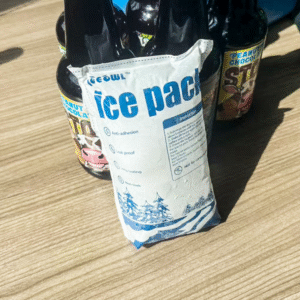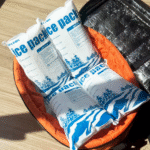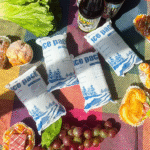Trockeneisschifffahrtspackung: How to Size and Label in 2025
If you need a dry ice shipping pack that actually stays frozen, start by sizing dry ice to transit hours, Auswahl der richtigen Isolierung, and printing UN 1845 with net kilograms on a vented box. Most lanes work with 5–10 lb per 24 hours plus a 24‑hour buffer, Und 2025 checklists require clear labels and vent paths for CO₂.
-
Wie viel Trockeneis pro Tag keeps goods frozen on your lane (mit einem Copy-Paste-Rechner).
-
What to print on the label so carriers accept your dry ice shipping pack the first time.
-
When to choose gel/PCM instead of a dry ice shipping pack to simplify air shipments.
-
Which insulation (EPS, Pur, VIP) right‑sizes cost and mass for 24–120 h routes.
Was ist a dry ice shipping pack und wann sollten Sie es verwenden?
Kurze Antwort: A dry ice shipping pack is a vented, insulated parcel that keeps payloads rock‑solid frozen using solid CO₂ (sublimes at −78.5 °C). Use it when your product must arrive fully frozen end‑to‑end; otherwise consider gel/PCM if chilled control is enough. Markieren „Trockeneis/Kohlendioxid, solide,”Und 1845, und Netz kg, and ensure gas can vent.
Warum es dir wichtig ist: Entlüftung verhindert Druckaufbau; correct markings speed acceptance and reduce delays. 2025 acceptance materials emphasize airline‑specific limits and providing net weight at booking, während USPS caps domestic air mail at ≤5 lb per piece and prohibits international mail with dry ice. If your lane is short or only needs chilled ranges, a gel/PCM pack avoids hazmat steps.
Dry ice shipping pack vs. gel/PCM—what fits your lane?
Choose a dry ice shipping pack when you need deep‑frozen conditions or ultracold lanes; choose gel/PCM when you need 2–8 °C or moderate frozen (Z.B., –15 ° C.) with simpler paperwork. Larger pellets or blocks sublimate slower for multi‑day routes; tiny pellets are better for fast pull‑down.
| Option | Temp capability | Heimat (Luft) | Was es für Sie bedeutet |
|---|---|---|---|
| Dry ice shipping pack | ≈ −78.5 °C surface | Ja | Lange hält; ultracold lanes; Etikett & Entlüftung erforderlich. |
| PCM –21 ° C. / −26 °C bricks | Gefroren (−15 to −26) | Normalerweise nein | Easier processing; wiederverwendbar; nicht ultrakold. |
| 0 Kommen ° C. / +5 ° C PCM | 2–8 ° C | NEIN | Kühlgüter; simple returns. |
Praktische Tipps, die Sie heute verwenden können
-
For DTC frozen food: Den Versender vorschreien; place product low, Trockeneis oben; Hohlräume füllen; leave vents unobstructed.
-
Für heiße Gassen (Sommer): Verwenden Sie das high end of 5–10 lb/day and consider PUR or VIP insulation.
-
Für Biologika: Add a data logger and record Netto-Trockeneis in kg on the label before tender.
Real -World -Fall: A pastry brand cut melted‑product claims by 38% after switching to a 2‑inch liner, larger pellets, and a 24‑hour buffer—ice spend stayed flat while failures plummeted.
How much dry ice should a dry ice shipping pack carry?
Faustregel: Planen ~ 5–10 lb (2.3–4,5 kg) pro 24 Std. von Transit plus an extra 24 Std. für Puffer. In der Nähe beginnen 7.5 LB/Tag and adjust for insulation, Umgebungswärme, Pelletgröße, and whether the box is opened mid‑route.
Warum funktioniert es: Dry ice absorbs substantial heat while subliming (≈570 kJ/kg), so modest masses can cover a day or two in a tight shipper. Box R‑value, Kopfspace, and pellet size drive real‑world loss rates.
Quick planner table
| Transitzeit | Typisches Trockeneis (lb) | Notizen |
|---|---|---|
| 12–24 h | 5–10 | Thick foam → 5; summer lanes → 10. |
| 24–48 h | 10–20 | Prefer larger pellets for slower loss. |
| 72 H | 20–30 | Consider bigger box or added liner. |
| 96 H | 30–40 | Validate with a lane test before scale. |
How should you label a dry ice shipping pack in 2025?
Print this on one panel (same surface as Class 9 when size allows):
Und 1845
Kohlendioxid, solide (Trockeneis)
Netto -Trockeneis: ____ kg
Absender: ____________________
Empfänger: ____________________
Für Luft, Wenden Sie die an Class9 Diamond, Verpackung weiter entlüftet, and follow IATA PI954. Airlines may impose additional limits and ask for net weight at booking. USPS permits ≤5 lb domestic air under PI 9A and prohibits international mail. Passenger flights allow ≤2.5 kg per person/package with airline approval and venting.
How do you pack out a dry ice shipping pack step by step?
-
Vorschreibe product and shipper to reduce the day‑one heat load.
-
Linie & isolieren: add a poly liner and absorbent pad; place a tray to avoid direct contact.
-
Laden: Produkt niedrig, Trockeneis oben; fill voids to reduce convection.
-
Schließen & Entlüftung: never seal the outer box airtight; keep gas paths clear of tape.
-
Etikett & Buch: markieren Und 1845 mit Netz kg, hinzufügen Class9 für Luft, und folge dem 2025 Akzeptanz -Checkliste.
Safety and ventilation: CO₂ limits to respect
Trockeneis wird zum Ko₂ -Gas. Indoors or in vehicles, gas can accumulate. Keep rooms ventilated and train staff. Reference limits: 5,000 PPM TWA Und 30,000 ppm stel; add CO₂ alarms in staging areas. Always use insulated gloves and eye protection.
Which insulation and pellet size fit your dry ice shipping pack?
Pick insulation for duration Und pellet size for endurance. EPS works for short lanes; PUR and VIP cut heat gain for 48–120 h routes and allow less refrigerant mass. Larger pellets or slabs sublimate slower on multi‑day lanes.
| Packungstyp | Typical window | Notizen | Bedeutung für Sie |
|---|---|---|---|
| EPS (1–2″) | 24–48 h | Lowest R‑value; niedrigste Kosten | Good for short lanes; more dry ice needed. |
| Pur | 48–96 h | Higher R/inch; konsistent | Reduce mass and carton size. |
| VIP | 72–120 h+ | Very high performance | Lange Gassen, high value payloads; lighter overall. |
2025 trends shaping your dry ice shipping pack
Was ist neu in 2025: IATA’s 66th Edition Addendum 1 (effective Apr 30, 2025) highlights airline‑specific dry ice limits and net weight at booking; carriers refreshed job aids stressing Class 9 placement with the Proper Shipping Name. USPS kept the ≤5 lb domestic air Kappe. VIP adoption keeps rising to trim refrigerant mass and freight.
Neueste Entwicklungen auf einen Blick
-
Clearer acceptance paperwork: Fewer dock delays if you mirror the 2025 Checkliste.
-
Preprinted cartons: More boxes ship with dry‑ice panels to reduce pack errors.
-
Market outlook: Several reports project ~7–7.4% CAGR for dry ice through 2032, led by food and healthcare demand.
Market insight: Near‑shoring and recyclable materials are trending, while IoT loggers make lane validation simpler and faster for audits.
Häufig gestellte Fragen
How much dry ice per day for a small dry ice shipping pack?
Planen 5–10 lb per 24 Std., Dann hinzufügen one extra day als Puffer; use more for hot lanes or thin walls.
What must appear on my label in 2025?
Enthalten Und 1845, “Trockeneis/Kohlendioxid, solide,” Netto-Trockeneis in Kilogramm, Versender/Empfänger, Und Class9; Halten Sie das Paket entlüftet.
Can passengers carry a dry ice shipping pack?
Ja, ≤2.5 kg (5.5 lb) pro Person/Paket mit Genehmigung der Fluggesellschaft; mark and vent the container.
Can I mail a dry ice shipping pack via USPS?
Domestic air only, ≤5 Pfund pro Postsendung; international mail is not allowed.
Is dry ice regulated for ground?
With some services (Z.B., certain ground networks), dry ice isn’t hazmat—but markings are still required. Check your carrier page for specifics.
When should I pick PCM instead of a dry ice shipping pack?
Wählen −15 °C to −26 °C PCM for many frozen lanes or 0 °C gel/+5 °C PCM for 2–8 °C when you want easier processing and reuse.
Zusammenfassung & Empfehlungen
Erinnern: Größe Ihre dry ice shipping pack von time first (5–10 lb/Tag + 24‑hour buffer), then select insulation (EPS → PUR → VIP) und Pelletgröße. Entlüften Sie die Kiste, drucken Und 1845 mit Netz kg, and place Class9 pro 2025 Anleitung. Trainieren Sie Teams weiter Co₂ -Exposition limits and stage packs in ventilated zones.
Nächste Schritte:
-
Estimate dry ice with the calculator above. 2) Print a label block with Und 1845 Und Netz kg. 3) Pilot two shipments and weigh post‑delivery to tune mass. 4) Fügen Sie die hinzu 2025 Akzeptanz -Checkliste to your SOP.
Über Tempk
We’re a cold‑chain engineering team that turns complex transport requirements into simple packout SOPs. Wir validieren dry ice shipping pack designs lane‑by‑lane, right‑size coolant loads, and provide label templates that pass first‑time acceptance. Customers in food and life sciences routinely cut claims by double digits while lowering re‑ship costs. Bereit, kälter zu versenden, sicherer, billiger? Anfrage a 15‑minute packout review and get a route‑specific BOM, Etiketten, and a tested ice calculator.
























